
A truffle is the fruiting body of a subterranean ascomycete fungus, predominantly one of the many species of the genus Tuber. In addition to Tuber, over one hundred other genera of fungi are classified as truffles including Geopora, Peziza, Choiromyces, and Leucangium. These genera belong to the class Pezizomycetes and the Pezizales order. Several truffle-like basidiomycetes are excluded from Pezizales, including Rhizopogon and Glomus. Truffles are ectomycorrhizal fungi, so they are usually found in close association with tree roots. Spore dispersal is accomplished through fungivores, animals that eat fungi. These fungi have significant ecological roles in nutrient cycling and drought tolerance.

Rhizopogon is a genus of ectomycorrhizal basidiomycetes in the family Rhizopogonaceae. Species form hypogeous sporocarps commonly referred to as "false truffles". The general morphological characters of Rhizopogon sporocarps are a simplex or duplex peridium surrounding a loculate gleba that lacks a columnella. Basidiospores are produced upon basidia that are borne within the fungal hymenium that coats the interior surface of gleba locules. The peridium is often adorned with thick mycelial cords, also known as rhizomorphs, that attach the sporocarp to the surrounding substrate. The scientific name Rhizopogon is Greek for 'root' (Rhiz-) 'beard' (-pogon) and this name was given in reference to the rhizomorphs found on sporocarps of many species.

The Sclerodermataceae are a family of fungi in the order Boletales, containing several genera of unusual fungi that little resemble boletes. Taxa, which include species commonly known as the ‘hard-skinned puffballs’, ‘earthballs’, or 'earthstars', are widespread in both temperate and tropical regions. The best known members include the earthball Scleroderma citrinum, the dye fungus Pisolithus tinctorius and the 'prettymouths' of the genus Calostoma.
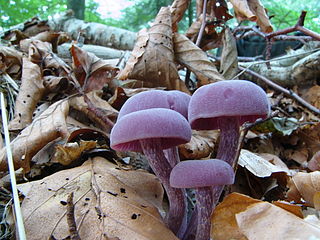
The Hydnangiaceae are a family of fungi in the mushroom order Agaricales. Widespread in temperate and tropical regions throughout the world, the family contains about 30 species in four genera. Species in the Hydnangiaceae form ectomycorrhizal relationships with various species of trees in both coniferous and deciduous forests.

The Albatrellaceae are a family of fungi in the order Russulales. The family contains 9 genera and more than 45 species.

Gautieria is a genus of hypogeal fungi in the family Gomphaceae. They form mycorrhizae with various tree species, mostly from the family Pinaceae. Species are present over much of the world's temperate and boreal forest habitats. It is well documented that species from this genera are an important part of the diet of the northern flying squirrel. Also, some Australian marsupials, especially the rat-kangaroos, feed extensively on these fungi. The fungi also benefit from this relationship: not only do the squirrels help to disperse the spores and propagate the species, studies suggest that passage through the digestive tract of a mammal promotes germination of spores.

Rhizopogonaceae are a family of fungi in the order Boletales. The family, first named and described by botanists Ernst Albert Gäumann and Carroll William Dodge in 1928, contains 2 genera and 151 species. The genus Fevansia, formerly thought to belong in the Rhizopogonaceae, was found to belong in the Albatrellaceae in a molecular phylogenetics study.
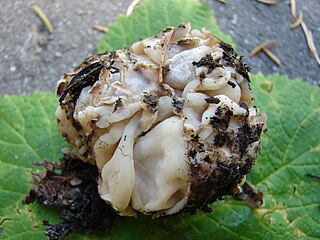
Geopora is a genus of truffle-like fungi in the family Pyronemataceae, currently with 13 described species. The genus was circumscribed by mycologist Harvey Willson Harkness in 1885. Molecular phylogenetic reconstructions indicate that the cup-like apothecial Geopora should better be placed back in a separate genus, Sepultaria. Geopora would then only comprise Geopora cooperi and its close relatives.

Alpova is a genus of fungi in the family Boletaceae. The genus contains about 20 species of ectomycorrhizal false-truffles that collectively have a widespread distribution, especially in northern temperate areas. The genus was circumscribed by Carroll William Dodge in 1931.
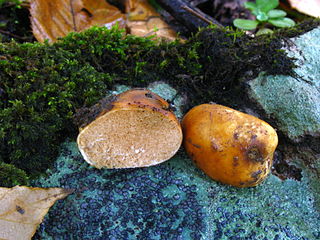
Zelleromyces is a genus of fungi in the family Russulaceae. It was first described by mycologists Rolf Singer and Alexander H. Smith in 1960 to contain hypogeous (underground) fungi with gasteroid fruit bodies that "bleed" latex when they are cut.

Setchelliogaster is a genus of fungi in the order Agaricales. It is incertae sedis with respect to familial placement within the order, although Kirk and colleagues consider it likely aligned with either the Bolbitiaceae or the Cortinariaceae. Species Fungorum class it as in the Bolbitiaceae family. The genus is widespread in warm, dry areas, originally containing five species, later degraded to 3 species. It was circumscribed by Czech mycologist Zdeněk Pouzar in 1958.
James Martin Trappe is a mycologist and expert in the field of North American truffle species. He has authored or co-authored 450 scientific papers and written three books on the subject. MycoBank lists him as either author or co-author of 401 individual species, and over the course of his career he has helped guide research on mycorrhizal fungi, and reshaped truffle taxonomy: establishing a new order, two new families, and 40 individual genera.
Carroll William Dodge was an American mycologist and lichenologist. His major fields of study included human and mammalian parasitic fungi, lichen-associated fungi, and fungi forming subterranean sporophores.
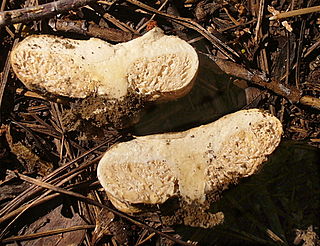
Arcangeliella is a genus of gasteroid fungi in the family Russulaceae. Taxonomic and phylogenetic research has shown that it is very likely a synonym of Lactarius. The type species Arcangeliella borziana was moved to Lactarius in 2003. However, the genus name is still in use for several species for which new combinations have not yet been proposed.

Rhizopogon occidentalis is an ectomycorrhizal fungus in the family Rhizopogonaceae of the Basidiomycota. It occurs most commonly in western North America in association with two-needle and three-needle pine hosts. They are false truffles with fruiting bodies that are yellow on the surface and pale yellow inside. Their edibility is disputed.
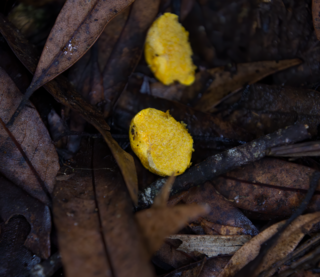
Stephanospora is a genus of truffle-like gasteroid fungi in the order Agaricales. In 2014, nine new Australasian species were described from collections previously thought to represent S. flava.
Dr Teresa Lebel is a taxonomist and ecologist who works on fungi, with a particular interest in subterranean truffle-like fungi and their mushroom, bolete, bracket or cup relatives.

Mastodia is a genus of lichen-forming fungi in the family Verrucariaceae. It has six species.














